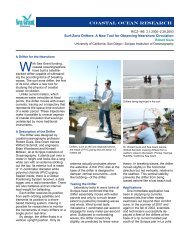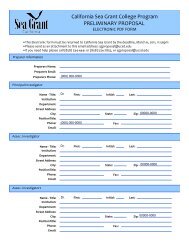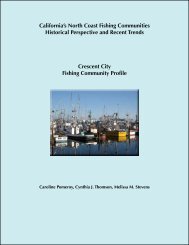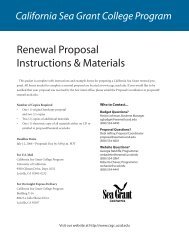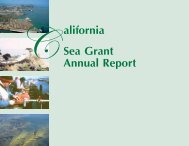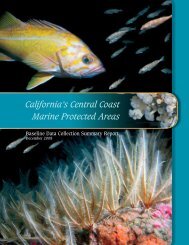PAT-UC Covers - California Sea Grant - UC San Diego
PAT-UC Covers - California Sea Grant - UC San Diego
PAT-UC Covers - California Sea Grant - UC San Diego
Create successful ePaper yourself
Turn your PDF publications into a flip-book with our unique Google optimized e-Paper software.
Program Overview<br />
Welcome to <strong>California</strong> <strong>Sea</strong> <strong>Grant</strong> (CSG). The pages that<br />
follow contain an overview of the organization and<br />
management of the program, brief descriptions of program<br />
components, information regarding planning activities,<br />
benchmark data on program attributes, information on finances<br />
and a sampling of portfolios. All of this material is oriented<br />
toward the past five years, March 1998 through February 2003.<br />
<strong>California</strong> occupies approximately two-thirds of the West Coast<br />
of the contiguous continental United States. The state stretches<br />
more than 1750 km from the Mexican border to the 42nd<br />
Parallel. The <strong>California</strong> coastal environment is remarkably<br />
diverse and encompasses two distinct marine zones. In the<br />
northern part of the state, the coast is characterized by cold<br />
water swept south from Alaska by the <strong>California</strong> Current,<br />
high-energy rocky coastlines and northern and transition zone<br />
marine flora and fauna. South of Point Conception (near <strong>San</strong>ta<br />
Barbara), the coast has warmer water fed by the <strong>California</strong><br />
Counter Current, lower energy coasts with sandy beaches,<br />
and marine flora and fauna common to more temperate and<br />
subtropical waters. The continental shelf is quite narrow,<br />
ranging from less than 3 km to no more than 16 km. Against<br />
this backdrop is a rich coastal marine flora and fauna with<br />
more than 525 species of fish, kelp forests, large populations of<br />
marine mammals and shorebirds, and high rates of productivity.<br />
This diversity and richness of <strong>California</strong>’s coastal environment<br />
is challenged by human encroachment. Over 80 percent of<br />
<strong>California</strong>’s 34 million residents live in coastal counties. The<br />
coastal environment has historically been rich in fisheries and<br />
mineral resources. Entire <strong>California</strong> coastal communities were<br />
founded on fisheries such as sardines and tuna. Oil drilling<br />
platforms still characterize the <strong>San</strong>ta Barbara Channel. Two<br />
enormous commercial seaports are found in Long Beach-Los<br />
Angeles and Oakland-<strong>San</strong> Francisco, and a large military port<br />
in <strong>San</strong> <strong>Diego</strong>. Tourism is a major industry with Huntington<br />
Beach drawing almost as many visitors per year as all the<br />
beaches in Delaware. Tens of thousands of surfers enjoy the<br />
waves along the southern coasts. However, major problems<br />
exist from coastal water pollution, depletion of fisheries, loss<br />
of wetlands, urbanization of the coastline and introductions of<br />
exotic species. The challenges to managing and preserving this<br />
environment are extensive.<br />
Against this backdrop, CSG has developed a program that<br />
encompasses a wide diversity of issues in research, education<br />
and outreach. Major foci for the program are coastal sciences,<br />
coastal fisheries, aquaculture, and marine biotechnology,<br />
with smaller efforts in marine policy and law, and marine<br />
engineering.<br />
<strong>California</strong> <strong>Sea</strong> <strong>Grant</strong> is the largest of the thirty <strong>Sea</strong> <strong>Grant</strong><br />
Programs nationwide. The annual budget of the program is<br />
approximately $8 million from all sources, including matching<br />
funds. From its beginning, the program has been characterized<br />
by excellence in research and graduate education. In <strong>California</strong><br />
an extraordinary pool of academic talent has driven research in<br />
marine sciences, and many high-caliber students are associated<br />
with those researchers. CSG typically supports forty-five to<br />
fifty concurrent research projects at up to $100,000 per year for<br />
a maximum of three years. In addition to the research funds<br />
for each project, additional support for one or two graduate<br />
students called “<strong>Sea</strong> <strong>Grant</strong> trainees” is provided.<br />
Until recently, the outreach portion of CSG was tailored<br />
primarily to reflect the research effort. The six marine advisors<br />
and two specialists have had a research component in their<br />
position descriptions that was matched to one of the six<br />
program foci. In a similar vein, the communications effort of<br />
CSG was almost exclusively focused on technical publications<br />
such as proceedings of symposia, resource books and peerreviewed<br />
publications.<br />
In the past few years, CSG has undergone a transition,<br />
particularly in outreach. While continuing to support<br />
approximately the same number of research projects and<br />
graduate students, the program has sought to diversify and<br />
broaden its outreach activities. This is driven by a desire to<br />
reach a larger constituency and a conscious effort to better<br />
integrate all aspects of the program into a research-outreach<br />
continuum. Examples of this continuum include: results of<br />
research routinely recast into a style and format readily used<br />
by the news media, placement of research feature articles in<br />
popular media, technical workshops organized for specific<br />
user groups, and conferences and symposia that bring together<br />
researchers and outreach staff.<br />
Following is a broad-brush view of CSG. The reader is<br />
encouraged to request additional materials for any item(s) that<br />
pique their interest.<br />
Redfish (male), Pimelometopon pulcher (Ayers). <strong>San</strong> <strong>Diego</strong>. (1882)<br />
1<br />
<strong>California</strong> <strong>Sea</strong> <strong>Grant</strong>: 1998-2003



